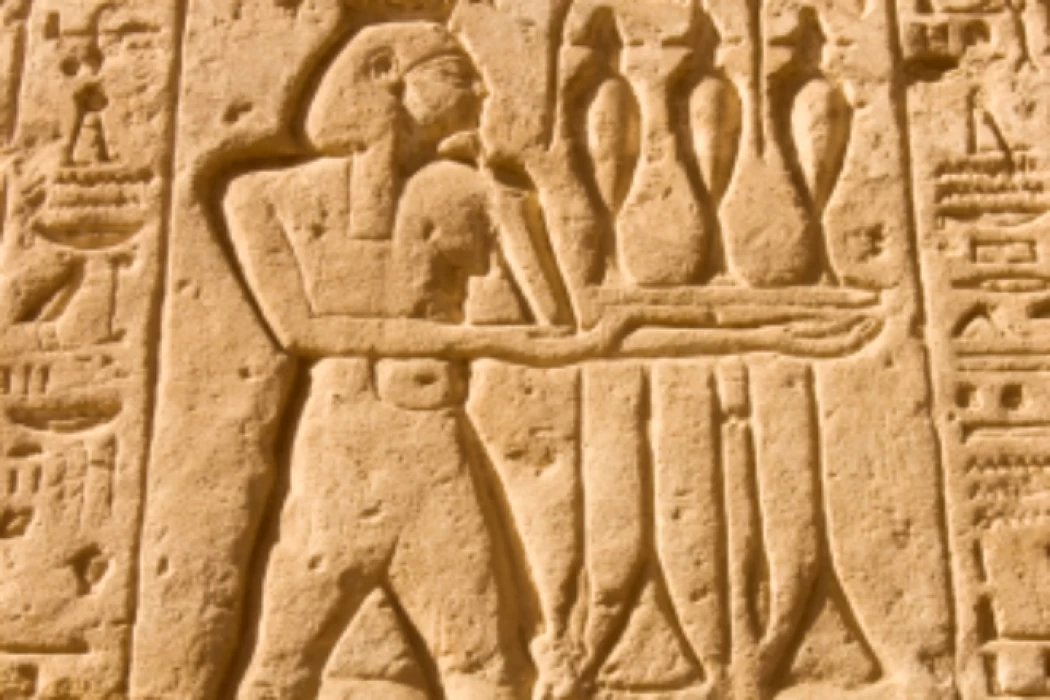
Il Dio del Nilo Hapi | Il Dio della fertilità | Il Dio del Nord e del Sud
Secondo gli storici, Hapi (Hapy, Hap, Hep) era molto probabilmente un nome preistorico del fiume Nilo stesso. Ciò avvenne quando la gente iniziò a venerarlo come divinità della piena annuale del fiume. In seguito, la gente cambiò il nome in Nilo o Itero, che significa "fiume". Di conseguenza, anche gli antichi Egizi cambiarono il nome del dio Nilo in "Il fiume" o Itero.
Per capire meglio, la parola egiziana "Nwy" significa acqua. Il nome "Nilo" deriva dalla corruzione greca di "Neilos", derivato da "Nwy". La gente diede a Hapi altri titoli, tra cui "Signore dei pesci e degli uccelli della palude" e "Il verde delle due rive". La gente lo chiamava anche "il creatore dell'orzo e del grano" e "il padrone del fiume che porta la vegetazione". Come altre divinità romane e greche, la mitologia ritiene che Hapi avesse una personalità benevola e bonaria. Tuttavia, aveva anche un lato oscuro che poteva causare distruzioni imprevedibili. Si sostiene inoltre che la divinità operasse sotto l'influenza del faraone, anch'egli una divinità vivente. Inoltre, i testi lo descrivono come "Siddik Geb", il dio egizio della terra e "Rab Nabar", il dio del grano.
L'inondazione del Nilo dovuta al "Diluvio" era così vitale per la vita e l'economia dell'Egitto che gli antichi basavano la loro vita su di essa. Ogni anno un'enorme quantità d'acqua trabocca dalle rive del Nilo e lascia del limo nero. Questa quantità d'acqua sostiene l'agricoltura in Egitto e mantiene la popolazione in salute.
La storia si riferisce a questa inondazione annuale come all'"Arrivo di Hapi". La gente celebrava questo evento con grandi feste e organizzava processioni sul fiume. Seguaci da tutto il mondo si recavano ai santuari di Hapi di Elefantina e Assuan. Pregavano per ottenere la giusta quantità di inondazione e di limo che li aiutasse a far crescere i loro raccolti.
Si può solo immaginare il rispetto e la devozione che essi nutrivano per il dio delle piene del Nilo. L'importanza di Hapi porta alcune persone a venerarlo al di sopra del potente dio del sole Ra. La divinità controllava le acque del Nilo stesso, influenzando così il benessere di milioni di persone.
Le persone attribuivano o eliminavano alcuni tratti di Hapi a seconda della regione in cui vivevano. Nel Basso Egitto, il dio era vestito di papiro e frequentato da rane. Nell'Alto Egitto, invece, abbondavano i loti e i coccodrilli. Per questo motivo, gli abitanti della regione associavano a Hapi i simboli di entrambi. Raramente si usava l'ippopotamo blu per raffigurare la divinità.
Molte immagini raffigurano Hapi mentre porta offerte di cibo o versa acqua da una brocca. L'iconografia del XIX secolo raffigura Hapi come una coppia di figure che collegano e uniscono gli steli di due piante. Queste piante rappresentano l'Alto e il Basso Egitto. Questa descrizione collega le due sezioni attorno al simbolo dell'unione.
Gli abitanti di Hapi nell'Alto Egitto chiamavano Hap-Meht, mentre gli Egizi del Basso Egitto chiamavano Hapi Hap-Reset. Si può trovare questa rappresentazione simbolica scolpita nella base delle statue del faraone seduto. Ad esempio, nel Tempio di Luxor si trova un'incisione in pietra di Hapi ai lati della statua seduta di Ramesse II. Inoltre, si possono vedere immagini di Hapi sul Colosso di Memnon nel Tempio di Amenhotep III.
Non esistono templi dedicati al dio Hapi, ma si possono trovare molte statue e rilievi del dio nei templi di altre divinità. Il popolo adorava il dio in tutta la terra d'Egitto, ma lo venerava soprattutto a Swenet e a Gebel el-Silsilah. Il popolo adorava Khnum, Satit e Ankot a Elefantina insieme al dio Hapi. I suoi sacerdoti sull'isola di Elefantina avevano un nilometro per misurare e monitorare i livelli del Nilo.
Historians say that Hapi (Hapy, Hap, Hep) was most likely a prehistoric name for the Nile River itself. It happened when people began to worship him as the deity of the annual flood of the river. Later on, people changed the name to Nile or Itero, which means "river". Hence, the ancient Egyptians also changed the name of the Nile god to “The River” or Itero.
To better understand this, the Egyptian word “Nwy” means water. The name “Nile” comes from the Greek corruption of “Neilos,” derived from “Nwy.” People gave Hapi other titles, including "Lord of the Fish and the Birds of the Marsh" and "The Green of the Two Banks". People also called him “the maker of barley and wheat” and “the master of the river that brings vegetation.” Like other Roman and Greek deities, mythology believes Hapi to have a benevolent and good-natured personality. However, he also had a dark side that could cause unpredictable destruction. People also claim that the deity worked under the influence of the pharaoh, who was also a living deity. Moreover, the texts describe him as “Siddik Geb,” the Egyptian god of the earth and “Rab Nabar,” the god of grain.
The flooding of the Nile due to the "Flood" was so vital to the life and economy of Egypt that the ancients based their lives around it. Every year a huge amount of water overflows the banks of the Nile and leaves black silt. It will support agriculture in Egypt and keep people fed.
The history refers to this annual flood as the "Arriving of Hapi". People celebrated this event with great festivals and organized processions on the river. Followers from all over the world would travel to the Hapi shrines of the Elephantine and Aswan. They were praying for the right amount of flood and silt to help them grow their crops.
One can only imagine the respect and devotion they would have for the Nile flood god. Hapi's importance leads to some people worshiping him above the powerful sun god Ra. The deity controlled the waters of the Nile itself and thus affected the well-being of millions of people.
People gave or removed some Hapi traits according to the region in which they live. In Lower Egypt, the god was dressed in papyrus, and was attended by frogs. In contrast, Upper Egypt had an abundance of lotuses and crocodiles. Hence, the people of the region associated the symbols of both with Hapi. People rarely used the blue hippopotamus to depict the deity.
Many images depict Hapi as carrying offerings of food or pouring water from a jug. Nineteenth-century iconography depicts hapi as a pair of figures connecting and linking together the stems of two plants. These plants represent Upper and Lower Egypt. This description connects the two sections around the union symbol.
The people of Hapi in Upper Egypt called Hap-Meht, while the Lower Egyptians called Hapi Hap-Reset. One can find this symbolic representation carved into the base of statues of the seated pharaoh. For example, one can find a stone carving of Hapi in the Luxor Temple on either side of a seated statue of Ramesses II. Also, you can spot images of Hapi on the Colossus of Memnon in the Temple of Amenhotep III.
There are no temples for the god Hapi, but one can find many statues and reliefs of the god in the temples of other gods. People worshiped the god all over the land of Egypt, but they revered him most in Swenet and Gebel el-Silsilah. The people worshiped Khnum, Satit and Ankot in Elephantine with the god Hapi. His priests on Elephantine Island had a nilometer to measure and monitor the levels of the Nile.
Statues of the god Hapi are found in many places, the most famous of which is the statue in Britain. Another statue I extracted myself from the Temple of Ramses II in Akhmim is a magnificent representation of Egypt's southern and northern faces.
Another statue is located in the Temple of Abu Simbel. Murals and images of Hapi are found in all Egyptian temples, given his sanctity to all Egyptians and his association with the sacred river, which Pharaonic legends said was the result of the tears of the goddess Isis.















